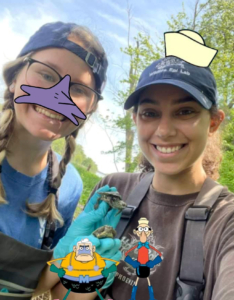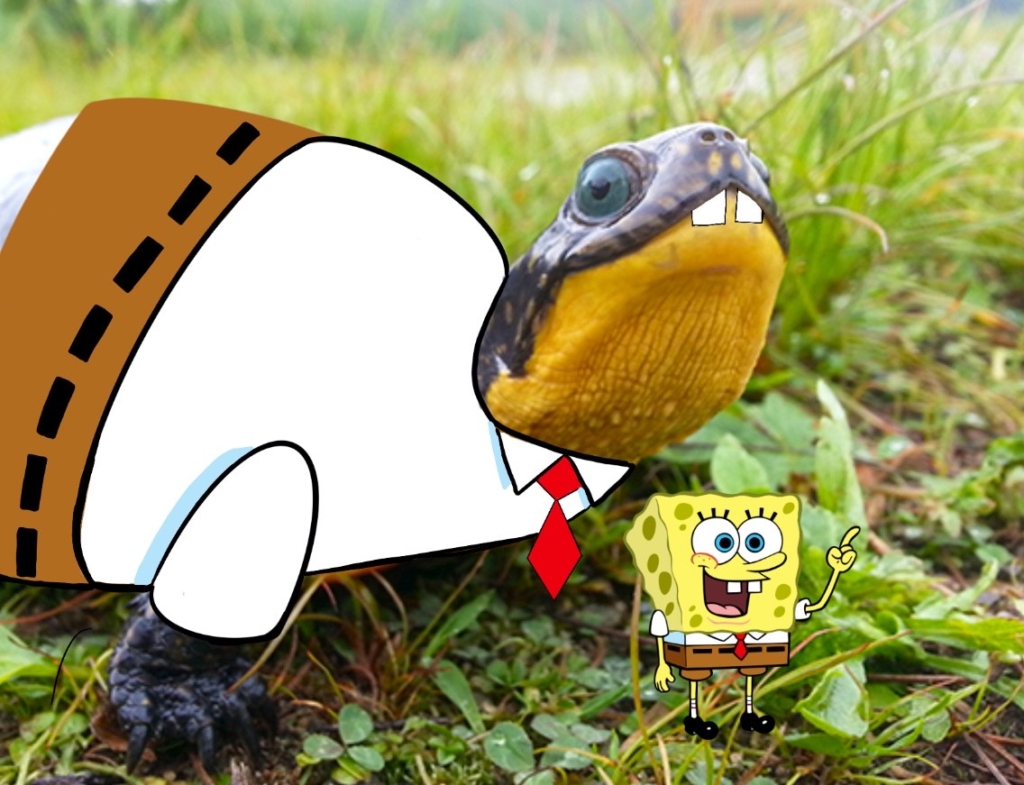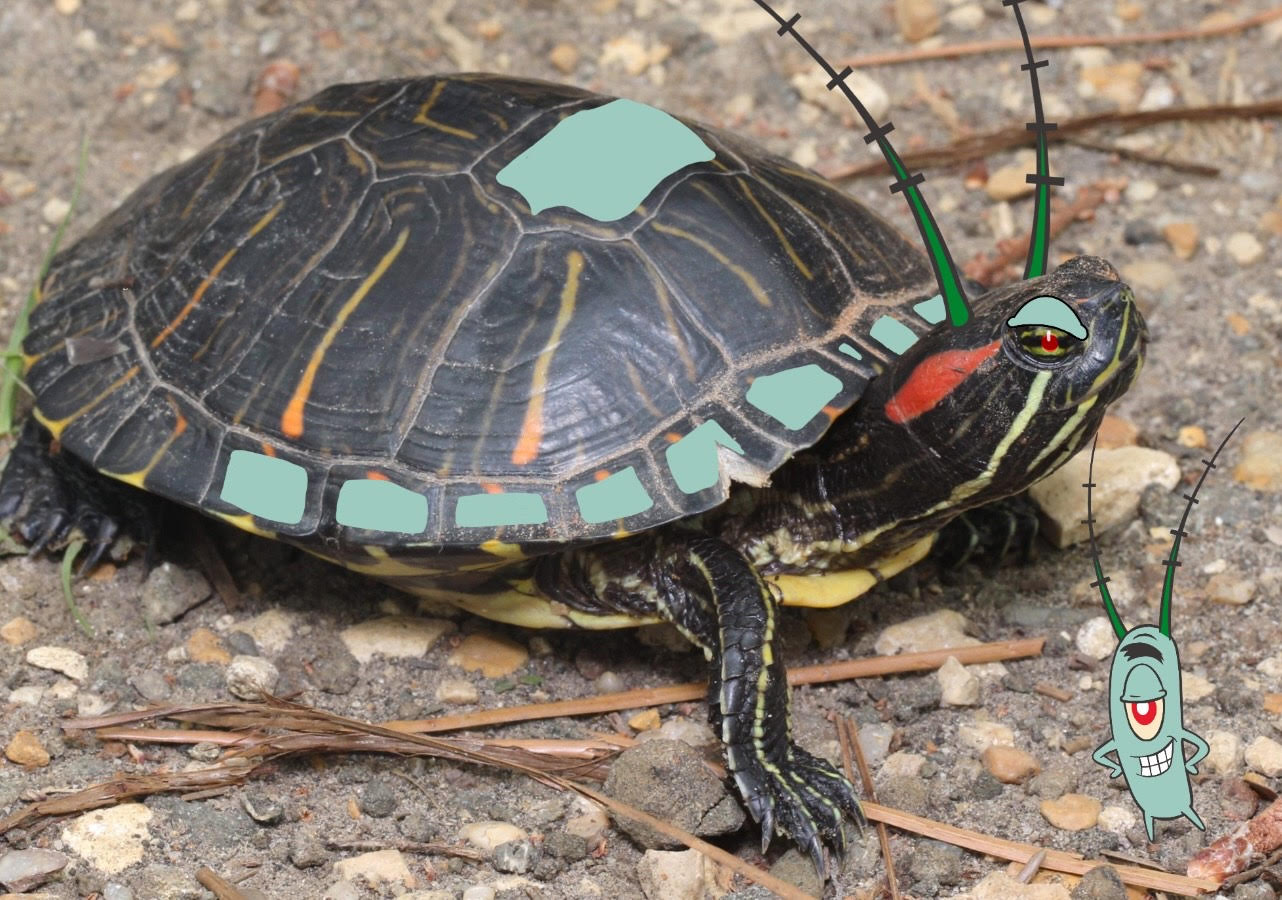We are proud to present to you the collaboration of the generation as we compare our shelly sidekicks to SpongeBob’s notorious crew!

Blanding’s Turtles are the main character of the show aka SpongeBob. Not only do most of the Wildlife Epidemiology Lab’s projects surround the health of blanding’s turtles, they also have bright yellow coloration underneath their jaw just like the color of SpongeBob. Every episode is like a WEL research project, focusing on a different aspect of blanding’s health. Blanding’s are native to the northern half of Illinois and are an important indicator of health of aquatic environments. Currently they are endangered in cook county mainly due to predation and habitat fragmentation. Blanding’s turtles are shyer and less outgoing when meeting new people, hiding in their shells when they are sampled. Once you get them out of their shell, they are just like Spongebob, friendly and relatively easy to work with!

———-
Painted Turtles are like our friendly neighbor patrick star. It seems like Patrick is almost always by SpongeBob’s side. At every site we have sampled in Cook County we have been able to find a plethora of painted turtles. Patrick is not known for his intellectual capabilities and neither are painteds, as they often are found in every one of our traps! Painted turtles are probably the easiest to work with because they can be coaxed into almost anything.

———-
Softshell Turtles typically inhabit sandy rivers where we do the majority of our trapping. Along with their long and rather distinct noses, there are many other characteristics that squidward and softshells share. Temperament is one of them, squidward is a bit grumpy just like our softshell turtles. They prefer to be left alone in their habitat, and will try to get out of their ‘job’ of being sampled as fast as possible. They can be quite sassy and have been known to use their long necks to reach back to take a bite out of you if they can. Although squidward and softshells aren’t the most friendly, it’s hard not to love them with their unique features and personality.

———-
Red Eared Sliders are an invasive species in our county and thus are most similar to the infamous antagonist plankton. Although they don’t cause Blanding’s any direct harm, they can be nuisance by taking up resources. Many RES have been released into the ecosystem oftentimes by pet owners who no longer want them, fortunately for the turtles they have been a little too good at getting in touch with their wild side and typically flourish in these environments. Not only do Blanding’s and RES like a similar habitat, they also enjoy most of the same vegetation and bait. SpongeBob (or the Blanding’s) are constantly defending themselves from Plankton or (RES) for the Krusty Krab Formula (resources).

———-
Map Turtles are the most underrated turtle, because they aren’t talked about enough. Although map turtles are not as widespread, they are unproblematic and usually pretty easy to work with, however they are often overlooked due to their resilience and constant population. Similar to Sandy, who is an underrated character and often gets dragged into SpongeBob and Patrick’s shenanigans. They are well known for their unique map-like design on the scutes of their carapace making them distinct just like Sandy (as she is the only mammal occupying bikini bottom). Additionally, map turtles have hard keratinized beaks that allow them to eat crunchy crustaceans just like Sandy’s teeth allow her to feed on nuts!

———-
Common Snapping Turtles are most similar to Mr. Krabs, with their razor sharp claws and strong jaw, they are definitely a force to be reckoned with. Mr. Krabs is a very money motivated crab and snappers are very food motivated, making them easy to find. When it comes to sampling snappers can be a bit of a handful sometimes. Like Mr. Krabs, they can be a bit of a ‘over reactor’ when something doesn’t go their way.

———-
Musk Turtles are pretty similar to SpongeBob’s loyal pet Gary. Both are small and relatively laid back little guys; often not getting much larger than palm size. They can sometimes turn/look a little feisty during handling just like Gary did in the splinter episode! Nevertheless many of the members of WEL get a lot of joy when they finally get their hands on one of these little guys just like the joy Gary provides SpongeBob.

———-
Raccoons are arguably the Blanding’s biggest opponent (besides themselves & urbanization). Like the dirty bubble ravages Bikini Bottom in SpongeBob, raccoons take every opportunity they can to cause problems to not only Blanding’s but also all of the other turtle species! Raccoons eat many types of aquatic turtles and even have the tendency to dig up their newly laid eggs for a quick snack.

